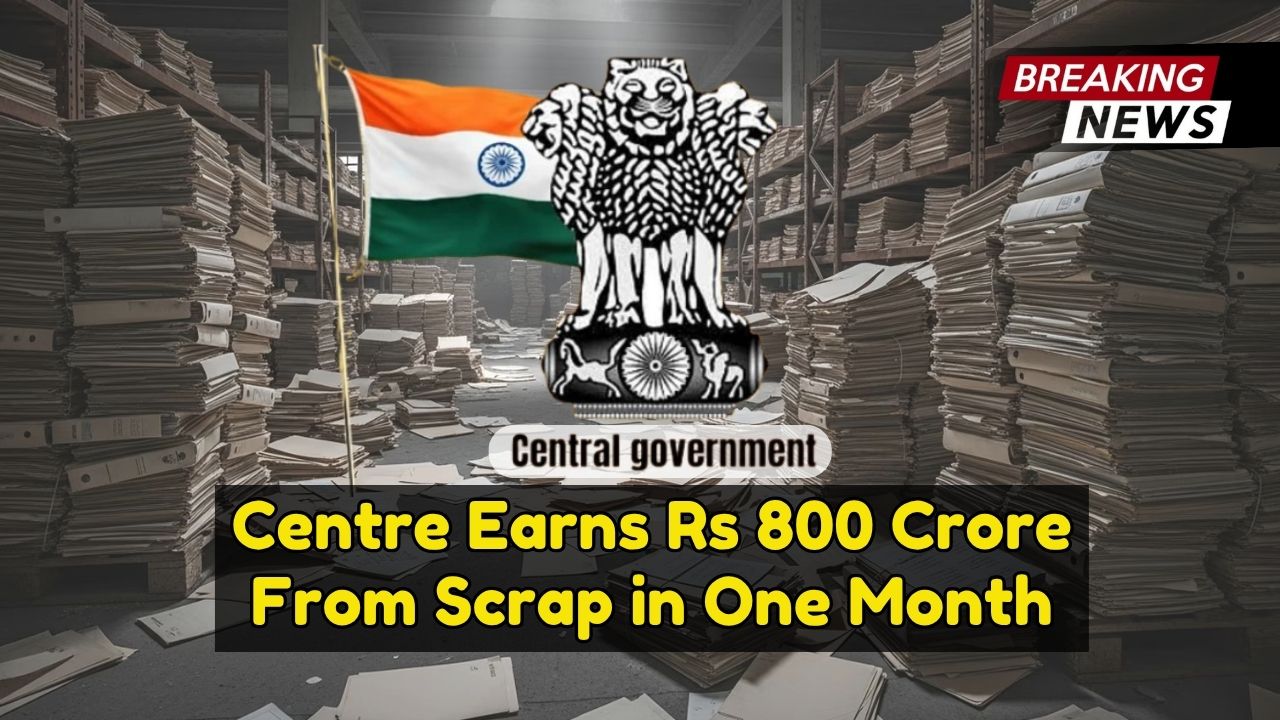A nationwide cleanliness and rationalisation campaign run in October 2025 delivered a striking financial and operational outcome for the Union government. Scrap disposal and file weeding across ministries and departments yielded Rs 800 crore in a single month, while clearing a record 232 lakh square feet of office space and weeding out 29 lakh physical files. Since the annual campaign began in 2021, cumulative receipts from scrap sales have climbed to nearly Rs 4,100 crore. Beyond the headline number, the effort signals how disciplined housekeeping, asset rationalisation, and de-cluttering can translate into immediate cash flows, lower carrying costs, and smoother citizen facing services.
The exercise was run under the aegis of the Department of Administrative Reforms and Public Grievances, with coordinated action by 84 ministries and departments, including overseas missions. Senior ministers provided oversight, ensuring that targets, audits, and disposal protocols were executed consistently across a very large footprint of about 11.58 lakh office sites.
Quick Summary

Item |
Details |
|---|---|
Month of Drive |
October 2 to October 31, 2025 |
Scrap Sale Proceeds in Oct 2025 |
Rs 800 crore |
Cumulative Scrap Proceeds since 2021 |
Nearly Rs 4,100 crore |
Files Weed-out in Oct 2025 |
29 lakh physical files |
Office Space Freed in Oct 2025 |
232 lakh sq ft |
Offices Covered |
About 11.58 lakh office sites |
Nodal Department |
Department of Administrative Reforms and Public Grievances |
Oversight |
Inter ministerial coordination across 84 ministries and departments |
Official Site |
What Exactly Was Achieved
1) Monetisation of Idle Assets
Obsolete furniture, e-waste, unserviceable equipment, and other non performing holdings were surveyed, catalogued, and auctioned through approved channels. The single month receipts added up to Rs 800 crore, demonstrating the scale of non productive stock sitting in government offices and the value that can be unlocked with standardised processes.
2) Space Reclamation
The drive freed 232 lakh sq ft across offices. Recovered space can be repurposed for productive uses such as citizen facilitation counters, training rooms, or consolidation to reduce rental outgo. Space recovery also enables densification of teams that currently operate in fragmented layouts.
3) Records Management
A total of 29 lakh paper files were weeded out based on retention schedules and archival norms. Digitisation and records appraisal helped remove duplication, cut retrieval time, and reduce the risks posed by decaying paper inventories.
4) Cross Ministry Coordination
The campaign aligned 84 central ministries and departments. Standard operating procedures, reporting templates, and compliance checklists helped maintain uniformity. Missions abroad were also covered, signalling a whole of government approach.
Why the Rs 800 Crore Matters
- Direct non tax revenue: Scrap disposal generates immediate receipts without imposing new levies.
- Lower lifecycle costs: Storing redundant assets has a real cost in rent, maintenance, and opportunity loss. Monetisation cuts these drains.
- Faster modernisation: Clearing outdated hardware accelerates transition to energy efficient equipment and cloud first workflows.
- Better public service delivery: De-cluttered workplaces and streamlined files improve turnaround time for citizen services.
For context, the Rs 800 crore collected in a single month is higher than the Rs 615 crore outlay reported for the Chandrayaan 3 mission, illustrating how operational housekeeping can unlock surprisingly large sums.
How Scrap Disposal and File Weeding Typically Work
- Survey and Identification: Departments create inventories of unserviceable items, redundant furniture, e-waste, and condemned vehicles.
- Valuation and Lotting: Items are grouped into lots with assessed base values, as per disposal rules and financial guidelines.
- Transparent Disposal: E-auction platforms, registered recyclers, or notified agencies are used for sale. E-waste follows environmental directives.
- Records Appraisal: Paper files are reviewed against retention schedules. Vital, policy, and legal records are archived. Eligible files are weeded with audit trails.
- Proceeds and Reporting: Receipts are deposited, and monthly dashboards track value realised, space freed, and compliance exceptions.
Environmental and Workplace Benefits
- Reduced landfill burden: Certified recyclers handle e-waste and metals, diverting materials from landfills.
- Lower energy footprint: Replacement of old appliances and lighting cuts consumption.
- Safer offices: Removal of broken fixtures and congested storage lowers fire and safety risk.
- Healthier workspaces: Clean, well organised floors improve morale and productivity.
What the Freed Space Enables
- Citizen centric areas: Front-office counters, grievance facilitation, and service kiosks.
- Training and skilling rooms: On site capacity building for frontline staff.
- Co location of teams: Better collaboration by placing interdependent units together.
- Consolidation to reduce rentals: Departments can move out of costly premises after densification.
Governance and Oversight
The Department of Administrative Reforms and Public Grievances served as the nodal coordinator. Three senior ministers, including portfolios linked to health, civil aviation, and administrative reforms, monitored progress. Ministries submitted periodical returns on scrap value realised, space reclaimed, and records weeded. This dashboard based oversight helped sustain pace across a very wide network of offices.
How Ministries and Offices Can Replicate the Gains
- Institutionalise quarterly audits of idle assets and e-waste.
- Set file retention triggers in electronic records systems so eligible files are flagged for appraisal on schedule.
- Adopt e-auction by default for transparent disposal.
- Tie space recovery to targets, for example square feet per employee, to anchor consolidation plans.
- Ring fence a portion of proceeds for modernisation and digitisation in the same office, creating a virtuous cycle.
Official Website
For guidelines, circulars, and future dashboards, visit the nodal department portal
https://darpg.gov.in
Frequently Asked Questions
1. How much did the Centre earn from scrap in October 2025
The government realised Rs 800 crore from scrap disposal during October 2025 as part of the national cleanliness and rationalisation drive.
2. What is the cumulative scrap revenue since the annual drive began in 2021
Total realisations have reached nearly Rs 4,100 crore up to the latest campaign.
3. Apart from money, what operational outcomes were achieved
About 232 lakh sq ft of office space was freed and 29 lakh physical files were weeded out, improving efficiency and enabling better use of premises.
4. Which department coordinated the exercise
The Department of Administrative Reforms and Public Grievances coordinated the campaign, aligning 84 ministries and departments with standard processes.
5. How is e-waste handled during such drives
E-waste is channelled to authorised recyclers in line with environmental regulations, ensuring safe recovery of materials and minimal landfill impact.
Conclusion
The October 2025 drive demonstrates that disciplined asset management can deliver large financial and operational payoffs. Rs 800 crore in one month, 232 lakh sq ft of space reclaimed, and 29 lakh files rationalised are not just statistics. They translate into cleaner offices, faster service delivery, and immediate funds that can be reinvested in digitisation, safety upgrades, and citizen centric facilities. With cumulative proceeds now near Rs 4,100 crore since 2021, sustained application of these methods can keep improving the state of public offices and the quality of governance across the country.
For More Information Click HERE










